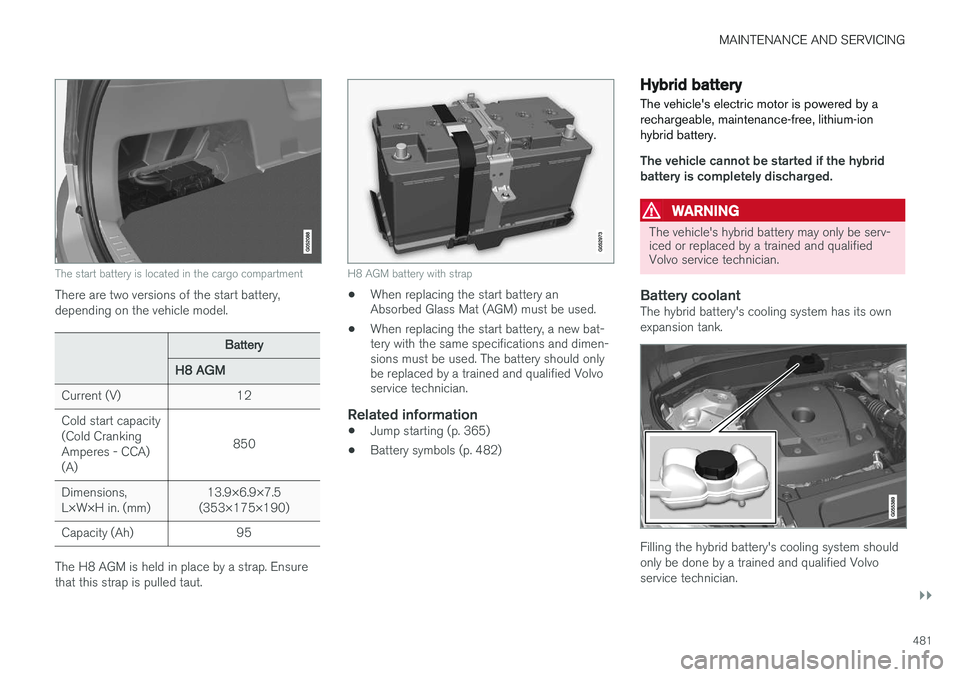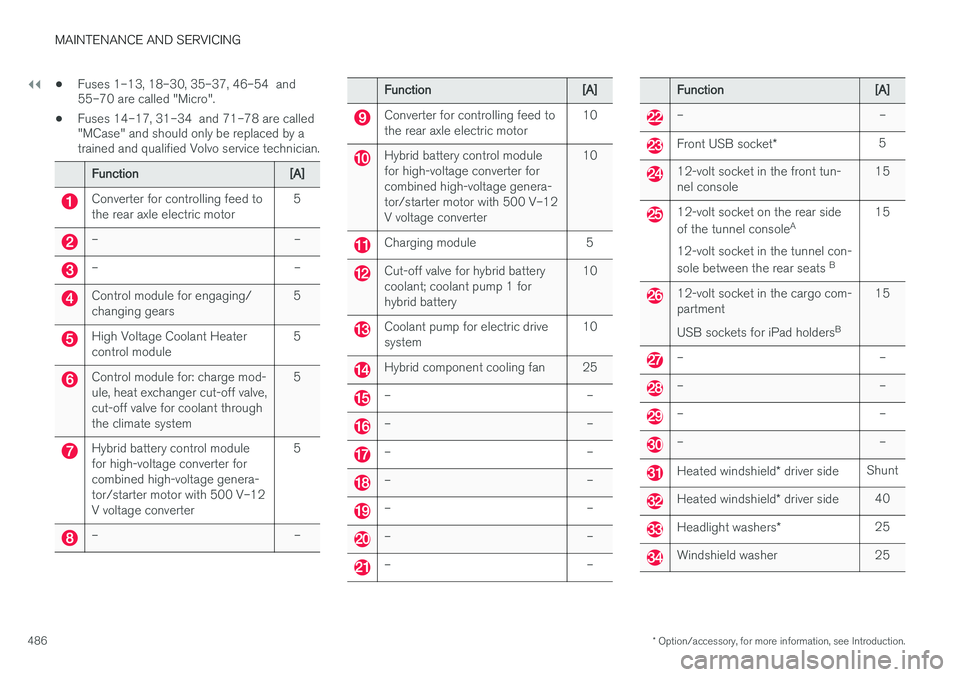Page 475 of 546

MAINTENANCE AND SERVICING
473
Emission inspection readiness
How do states use OBD II for emission
inspections?
Many states connect a computer directly to a vehicle's OBD II system. The inspector can thenread "faults." In some states, this type of inspec-tion has replaced the tailpipe emission test.
How can my vehicle fail OBD II emission
inspection?
Your vehicle can fail OBD II emission inspection for any of the following reasons.
• If your Check Engine (MIL) light is lit, your vehicle may fail inspection.
• If your vehicle's Check Engine light was lit,but went out without any action on your part,OBD II will still have a recorded fault. Yourvehicle may pass or fail, depending on theinspection practices in your area.
• If you had recent service that required dis-connecting the battery, OBD II diagnosticinformation may be incomplete and "notready" for inspection. A vehicle that is notready may fail inspection.
How can I prepare for my next
OBD II
emission inspection?
• If your Check Engine (MIL) light is lit – or was lit but went out without service, have yourvehicle diagnosed and, if necessary, servicedby a qualified Volvo technician.
• If you recently had service for a lit CheckEngine light, or if you had service that required disconnecting the battery, a periodof driving is necessary to bring the OBD IIsystem to "ready" for inspection. Two half-hour trips of mixed stop-and-go/highwaydriving are typically needed to allow OBD II toreach readiness. Your Volvo retailer can pro-vide you with more information on planning atrip.
• Maintain your vehicle in accordance with yourvehicle's maintenance schedule.
Owner maintenancePeriodic maintenance requirements and intervals are described in your vehicle's Warranty andService Records Information booklet. The following points can be carried out between the normally scheduled maintenance services.
Each time the car is refueled:
•Check the engine oil level.
• Clean the windshield, windshield wipers, headlights, and taillights.
Monthly:
•
Check cold tire pressure in all tires. Inspect the tires for wear.
• Check that engine coolant and other fluidlevels are between the indicated "min" and"max" markings.
• Clean interior glass surfaces with a glasscleaner and soft paper towels.
• Wipe driver information displays with a softcloth. •
Visually inspect battery terminals for corro-sion. Corrosion may indicate a loose terminalconnector, or a battery near the end of itsuseful service life. Consult your Volvo retailerfor additional information.
As needed:
Wash the car, including the undercarriage, to reduce wear that can be caused by a buildup ofdirt, and corrosion that can be caused by salt res-idues. Clean leaves and twigs from air intake vents at the base of the windshield, and from other placeswhere they may collect.
NOTE
Complete service information for qualified technicians is available online for purchase orsubscription at www.volvotechinfo.com.
Related information
•
Climate system service (p. 479)
Page 483 of 546

MAINTENANCE AND SERVICING
}}
481
The start battery is located in the cargo compartment
There are two versions of the start battery, depending on the vehicle model.
Battery
H8 AGM
Current (V)12
Cold start capacity (Cold CrankingAmperes - CCA)(A)
850
Dimensions, L×W×H in. (mm)13.9×6.9×7.5
(353×175×190)
Capacity (Ah)95
The H8 AGM is held in place by a strap. Ensure that this strap is pulled taut.
H8 AGM battery with strap
• When replacing the start battery an Absorbed Glass Mat (AGM) must be used.
• When replacing the start battery, a new bat-tery with the same specifications and dimen-sions must be used. The battery should onlybe replaced by a trained and qualified Volvoservice technician.
Related information
• Jump starting (p. 365)
• Battery symbols (p. 482)
Hybrid battery
The vehicle's electric motor is powered by a rechargeable, maintenance-free, lithium-ionhybrid battery.
The vehicle cannot be started if the hybrid battery is completely discharged.
WARNING
The vehicle's hybrid battery may only be serv- iced or replaced by a trained and qualifiedVolvo service technician.
Battery coolantThe hybrid battery's cooling system has its own expansion tank.
Filling the hybrid battery's cooling system should only be done by a trained and qualified Volvoservice technician.
Page 488 of 546

||
MAINTENANCE AND SERVICING
* Option/accessory, for more information, see Introduction.
486 •
Fuses 1–13, 18–30, 35–37, 46–54 and 55–70 are called "Micro".
• Fuses 14–17, 31–34 and 71–78 are called"MCase" and should only be replaced by atrained and qualified Volvo service technician.
Function[A]
Converter for controlling feed to the rear axle electric motor5
––
––
Control module for engaging/ changing gears5
High Voltage Coolant Heater control module5
Control module for: charge mod- ule, heat exchanger cut-off valve,cut-off valve for coolant throughthe climate system5
Hybrid battery control module for high-voltage converter forcombined high-voltage genera-tor/starter motor with 500 V–12V voltage converter5
––
Function[A]
Converter for controlling feed to the rear axle electric motor10
Hybrid battery control module for high-voltage converter forcombined high-voltage genera-tor/starter motor with 500 V–12V voltage converter10
Charging module5
Cut-off valve for hybrid battery coolant; coolant pump 1 forhybrid battery10
Coolant pump for electric drive system10
Hybrid component cooling fan25
––
––
––
––
––
––
––
Function[A]
––
Front USB socket
*5
12-volt socket in the front tun- nel console15
12-volt socket on the rear side of the tunnel console A
12-volt socket in the tunnel con-sole between the rear seats B15
12-volt socket in the cargo com- partment USB sockets for iPad holders B15
––
––
––
––
Heated windshield
* driver sideShunt
Heated windshield * driver side40
Headlight washers *25
Windshield washer25
Page 494 of 546
||
MAINTENANCE AND SERVICING
* Option/accessory, for more information, see Introduction.
492
FunctionA
Multi-band antenna module5
Front seat massage function5
––
Tailgate window wiper15
Fuel pump control module15
Relay windings for engine compart- ment electrical module; Relay wind-ing for transmission oil pump5
––
Driver side seat heating *15
Passenger side seat heating *15
Coolant pump10
––
Front driver-side door module20
Active chassis control module *20
––
Sensus control module10
––
FunctionA
––
Front passenger-side door module20
Display for rear seat convenience functionsA5A
––
Circuit breaker for fuses 53 and 5815
A
XC90 Excellence.
B Certain markets only.
Related information
• Fuses (p. 483)
• Replacing fuses (p. 483)
Page 508 of 546
||
MAINTENANCE AND SERVICING
506
•The distributor ignition system operates at very high voltages. Special safety pre-cautions must be followed to prevent injury. Always turn the ignition
off when
replacing distributor ignition components e.g. plugs, coil, etc.
• Do not touch any part of the distributorignition system while the engine is run-ning. This may result in unintended move-ments and body injury.
The layout of the engine compartment may differ slightly from model to model
Coolant expansion tank
Brake fluid reservoir
Washer fluid reservoir
Relay/fuse box
Air cleaner
Engine oil filler cap
Related information
• Ignition modes (p. 370)
• Opening and closing the hood (p. 504)
• Refilling the windshield washer fluid reservoir (p. 511)
Engine oil
The correct oil must be used for the stated oil change (service) intervals to apply.
Volvo recommends:
Page 530 of 546
SPECIFICATIONS
528
Brake fluid specification and volume
Brake fluid transfers braking force when the brake pedal is depressed to the master cylinderand to the slave cylinders on each wheel. Topping up or replacing brake fluid should only be done by a trained and qualified Volvo servicetechnician.
Specification: DOT 4 boiling point >536 °F
(>280 °C)
Related information
• Engine compartment overview (p. 505)
Coolant specifications and volumes
Coolant volumes and specifications.
Engine: T6 AWD Specification: Coolant with corrosion inhibitor mixed with water (50/50 mix), see packaging. Different types of coolant should not be mixed to help avoid health risks.
Page 531 of 546
SPECIFICATIONS
529
Engine specificationsThe following table provides technical data for the respective engines. Engine specifications forSpecial Edition vehicles may vary. Not all engines listed here are available in allmarkets.
SpecificationT8
Engine designationB4204T28
Output (kW/rps)233/100
Output (hp/rpm)313/6000
Torque (Nm/rps)400/37–90
Torque (ft. lbs./rpm)295/2200–5400
No. of cylinders4
Electric motorMax. power:
87/7000 (65 kW/117).
Torque: 240 Nm/0-50 rpm.
Related information
•Engine oil specifications and volume (p. 530)
• Coolant specifications and volumes (p. 528)
Page 537 of 546
INDEX
535
Electronic Climate Control 188
introduction 178, 188
passenger compartment filter 186
preconditioning 179, 181
rear controls 188, 190
recirculation 194
refrigerant 527
service 479
setting the temperature 192
voice commands 123
Clock 117
Cold weather driving 358
Collision warning system 288
Compass in rearview mirror 139 calibrate 139
Connected service booking 475
Convertible seats 74
Coolant 528 refilling 468
Corrosion protection 516
Courtesy lighting 148
Crash event data 30
Crash mode 87, 88
Cross Traffic Alert 333, 334, 335, 337
Cruise control 261, 262, 263, 264, 265 adaptive 266, 268, 269, 271, 272, 273 , 282 , 283 , 284 , 285 , 286
Curb weight 449, 525
D
Daytime running lights 140, 142 Defroster
rear window and mirrors 195
Detachable key blade 237, 248
Digital owner's manual 55, 56
Dimensions 523
Disconnecting the front passenger